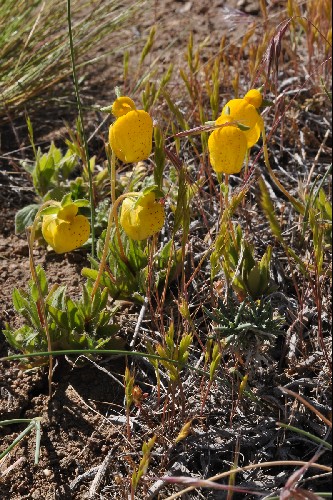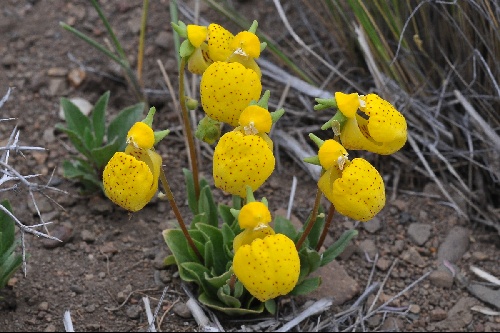Authors: Cav.
Forms stoloniferous mats of neatly tufted foliage 5-12cm tall. Leaves lanceolate, about 8cm long, acute to acuminate, tapering to a petiole of the same length. Those on the flowering stems are much smaller, narrower and very acute. Flowering stems erect or ascending, sparsely white hairy above and commonly bearing a solitary, rarely two, rich golden-yellow flowers. The top lip is slightly hooded and always marginally shorter than the ovate and acute calyx. The well inflated lower lip is bent down at first, then strongly upcurving, and has a doubled-up appearance, 1.5-2cm long by 8-12mm wide with variable amounts of reddish to very dark purplish spotting. Three varieties are recognised in the preparation for the new 'Flora of Chile', all of them at one time having had species rank. C.I. var. lanceolata is as described above with sparsely downy leaves and purple stems which frequently produce pairs of flowers. Chile and Argentina in the south from sea level to 1000m in dry creek beds of black rich stony loam among rocks. C.I. var. acutifolia is always solitary flowered on pale yellow stems, its red spotting sometimes so dense at the tip that it merges and blots out the yellow. The leaves are generally broader (to 2cm) and glandular whitish-hairy. It appears further north in central southern Chile and adjacent Argentina on gravelly, scrubby hillsides and loose volcanic sandy slopes at 800-2600m. C.I. var. pusilla is also single flowered on dark reddish-purple stems and has a more elongated pouch, narrower at the base. It has broader, obovate to lanceolate, softly hairy leaves to 4cm long. Central southern Chile only on slopes of loose volcanic sand at 2000m. Long confused botanically with C. polyrrhiza. This account has made use of a number of sources to try and clarify the situation.


Sign up for our newsletter to receive our monthly update direct to your inbox. Featuring our latest articles and news.
Built by Atomic Smash

